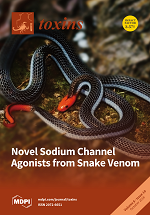Open AccessArticle
A Combinational Strategy upon RNA Sequencing and Peptidomics Unravels a Set of Novel Toxin Peptides in Scorpion Mesobuthus martensii
by
Ning Luan 1,†, Wang Shen 1,†, Jie Liu 2,3,†, Bo Wen 2,3, Zhilong Lin 2,3, Shilong Yang 4,5,6, Ren Lai 1,4,5,6,*, Siqi Liu 2,3,* and Mingqiang Rong 4,5,6,*
1
Life Sciences College of Nanjing Agricultural University, Nanjing 210095, Jiangsu, China
2
BGI-Shenzhen, Shenzhen 518083, China
3
China National GeneBank-Shenzhen, BGI-Shenzhen, Shenzhen, Guangdong 518083, China
4
Key Laboratory of Animal Models and Human Disease Mechanisms of Chinese Academy of Sciences & Yunnan Province, Kunming Institute of Zoology, Kunming 650223, Yunnan, China
5
United Laboratory of Natural Peptide of University of Science and Technology of China & Kunming Institute of Zoology, Chinese Academy of Science, Kunming 650223, Yunnan, China
6
Sino-African Joint Research Center, Chinese Academy of Science, Wuhan 430074, Hubei, China
†
These authors contributed equally to this paper.
Cited by 10 | Viewed by 6030
Abstract
Scorpion venom is deemed to contain many toxic peptides as an important source of natural compounds. Out of the two hundred proteins identified in
Mesobuthus martensii (M. martensii), only a few peptide toxins have been found so far. Herein, a combinational approach
[...] Read more.
Scorpion venom is deemed to contain many toxic peptides as an important source of natural compounds. Out of the two hundred proteins identified in
Mesobuthus martensii (M. martensii), only a few peptide toxins have been found so far. Herein, a combinational approach based upon RNA sequencing and Liquid chromatography-mass spectrometry/mass spectrometry (LC MS/MS) was employed to explore the venom peptides in
M. martensii. A total of 153 proteins were identified from the scorpion venom, 26 previously known and 127 newly identified. Of the novel toxins, 97 proteins exhibited sequence similarities to known toxins, and 30 were never reported. Combining peptidomic and transcriptomic analyses, the peptide sequence of BmKKx1 was reannotated and four disulfide bridges were confirmed within it. In light of the comparison of conservation and variety of toxin amino acid sequences, highly conserved and variable regions were perceived in 24 toxins that were parts of two sodium channel and two potassium channel toxins families. Taking all of this evidences together, the peptidomic analysis on
M. martensii indeed identified numerous novel scorpion peptides, expanded our knowledge towards the venom diversity, and afforded a set of pharmaceutical candidates.
Full article
►▼
Show Figures






